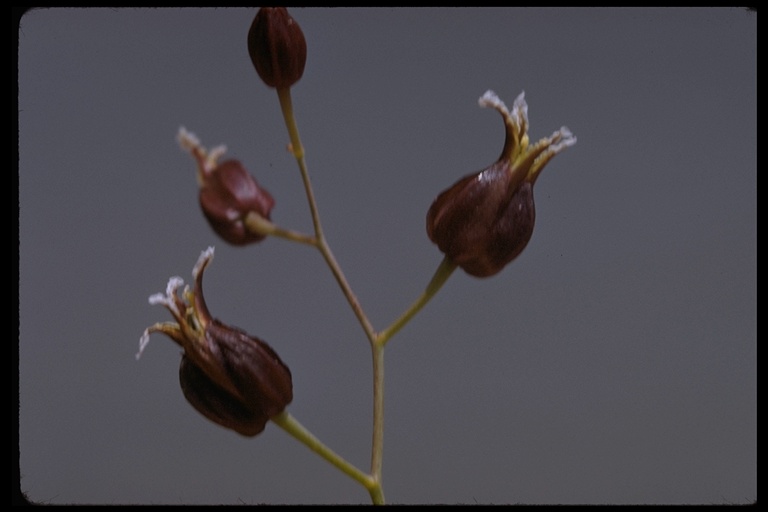- Streptanthus niger
Taxobox
name = Tiburon Jewelflower

image_width = 250px
image_caption = "S. niger".
credit: Charles Webber,
California Academy of Sciences
status = EN
status_system = iucn2.3
regnum =Plant ae
divisio = Magnoliophyta
classis = Magnoliopsida
ordo =Brassicales
familia =Brassicaceae
genus = "Streptanthus "
species = "S. niger"
binomial = "Streptanthus niger"
binomial_authority = Greene"Streptanthus niger" is an
endangered species within the familyBrassicaceae . Like other genus members, thisherb has wavypetal margins with perimeter calluses that discouragelarva l herbivory. [Kruckeberg & Morrison 1983 Madroño 30:230–244] This plant is endemic to the Tiburon Peninsula ["Marinero Estates Environmental Impact Report, Tiburon, California", Earth Metrics Inc., prepared for the city of Tiburon, Ca (1989)] ofNorthern California , and occurs at elevations below 150 meters on serpentinegrassland s. ["Jepson Manual",University of California Press (1993)] The common name for this species is Tiburon Jewelflower or Black Jewelflower. This annual herb blooms in May and June and displays dark purplesepal s. Theetymology of this genus scientific name derives from the Greek word "streptanthus", meaning "twisted flower", with reference to the notable wavy margins of the petals. The species name "niger" relates to the color of theseed s being black, although an alternate account cites the dark color of the petals as the source of the appellation.Morphology
"Streptanthus niger" is an annual herb attaining a height of 20 to 70 centimeters. The plant architecture may manifest as simple-stemmed or branching in the upper part. Lower portions of the stems are smooth and practically hairless. This self-pollinated plant has dark purple, almost black, flower petals; moreover, the
petals have a purple claw and a white blade with a purple midvein. The zig-zaginflorescence pattern is an identifying characteristic; furthermore, the flower is almost closed at its throat.Sepals measure five to seven millimeters. The characteristic wavy petal margins have calluses that inhibit larvalherbivory . The leaves of "S. niger" appear in a basal manifestation and measure less than nine centimeters in length; leaves are generally oblanceolate in shape, and may appear as coarselydentate or short-lobed. Chromosomal characterization is 2n=28.Habitat and range
There are only two known colonies of Tiburon Jewelflower, both of which occur on the Tiburon Peninsula, with a separation of about three kilometers. One of the populations is in the vicinity of the historic
Old St. Hilary's Church . The Federal Register listing document noted that "S. niger" occurs only ongrassland s above shallow serpentine soils involving gentle to moderate southwestern facing slopes. The listing statement further notes that: "Serpentine soils are derived fromultramafic rocks such asserpentinite ,dunite , andperidotite , which are found in discontinuousoutcrop s in the...Coast Ranges". [Federal Register : February 3, 1995 (Volume 60, Number 23) [Page 6671-6685] ] According to the Sacramento Fish and Wildlife Service: "species such as Tiburon jewelflower have adapted to serpentine soils and require them to survive". [ [http://www.fws.gov/sacramento/es/plant_spp_accts/tiburon_jewelflower.htm Sacramento Fish and Wildlife Office profile for "Streptanthus niger"] ]Conservation
The Tiburon Jewelflower was first collected by Edward L. Greene in the year 1886 at the site of Old Saint Hilary's Church on the Tiburon Peninsula. "Streptanthus niger" was designated as endangered by the state of California in the year 1990 and listed by the U.S. federal government five years later. By 1998 a "Species Recovery Plan" had been prepared to provide more specific protection measures for this endangered
dicotyledon . ["Recovery Plan for Serpentine Soil Species of the San Francisco Bay Area"U.S. Fish and Wildlife Service (1998)] For each of the two known colonies, the population has varied between 25 and 2000 over recent years, indicating the precariousness of the species. The California Native Plant Society has placed "S. niger" on List 1B (rare or endangered throughout its range).ee also
*
Rare species
*Recovery Plan References
External links
* [http://www.dfg.ca.gov/hcpb/cgi-bin/more_info.asp?idKey=ssc_tespp&specy=plants&query=Streptanthus%20niger California Department of Fish and Game summary of species "Streptanthus niger"]
* [http://plants.usda.gov/java/profile?symbol=STNI2 U.S. Department of Agriculture plant profile for "Streptanthus niger"]
Wikimedia Foundation. 2010.
